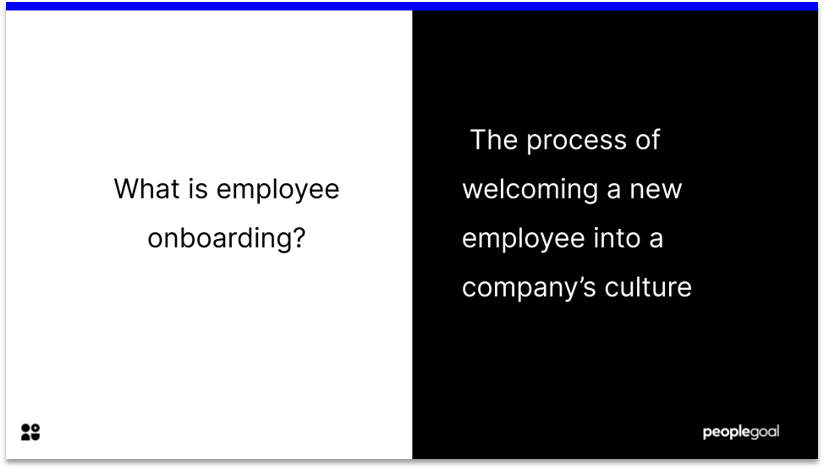Must-Have Checklist for Remote Employee Onboarding
Remote employee onboarding doesn’t have to be a compromise. Cross off these key points from our checklist to ensure a welcoming, productive onboarding process.

Below is a handy checklist for that all-important employee onboarding strategy.
What is employee onboarding?
Onboarding is the process of welcoming a new employee into a company and its culture. HR must ensure that new hires have the resources and information they need to perform in their new role.
The move to remote-work led HR to rapidly adapt their onboarding strategies. Virtual onboarding programs require planning, but can be very impactful.
How long should an onboarding process last?
Most of us will recall our first day in a new job vividly - our nerves, the people we met and the ritual demo of the coffee machine. But most of us are also aware that the challenges of starting a new role surpass these newbie jitters. It takes employees time to adjust to new working practices and schedules.
This is why SHRM recommends that any onboarding program lasts at least a year.
Of course, your strategy will change over this period as employees develop their skills and independence. Ensuring that they continue to have the support they need is crucial however.
Why does onboarding matter?
Research by Glassdoor found that companies with a strong onboarding process improve employee retention by 82% and productivity by over 70%. If you give a great first impression, employees are more likely to stick with the company long-term. New hires with direction and the resources they need will achieve better results.
Any organization that seeks a cohesive company culture should pay attention to onboarding. Remember that values are the building blocks of culture – ensure you are direct about what these are.
What are your expectations for employees? What are the behaviors you seek, or the workplace environment you strive for? These fundamentals are so crucial when we are new – they help keep us grounded as we navigate onboarding's challenges.
Benefits of a great onboarding process:
Boost employee retention
Improve productivity in the long-term
Better employee relations
Help new hires develop necessary skills
Supportive work environment
Clarity over company values and culture
How does remote employee onboarding differ?
New hires in companies across the world are onboarding virtually on a scale we haven’t seen before. This can be a strange process – with many employees working for months in a job without meeting their colleagues in person!
There are clearly potential issues here – as well as opportunities. Remote work provides the advantage of greater flexibility, with employees no longer required to commute every day. It can support a healthy work-life balance. Make this clear in your messaging – that your company seeks to adopt a positive remote work environment.
Areas for remote employee onboarding to focus on
Creating a social, friendly virtual environment
Communicating instructions clearly
Ensuring all new hires have the resources they need
Onboarding feedback
Remote Employee Onboarding checklist
Onboarding is multi-faceted. Draw up a checklist to make your life easier!
Our checklist outlines the employee onboarding process.
Before the Employee's Start Date
1) Complete a job requisition document
This ensures you have formal approval of a hiring decision.
2) Send out an offer letter
3) Organize a background check
These may differ depending on whether or not your company's internal practices. Make sure you are compliant.
4) Submit new hire paperwork
Required paperwork may include a background check form, non-disclosure agreement, employee information form and a direct deposit form.
You may also want to write an Employee Handbook, in which you detail conditions of employment and useful information about your company.
Draw up a list of forms and ensure that deadlines are set for completion.
5) Send out a welcome email before the first day
This clarifies expectations of the new hire. Congratulate them on their new role and highlight how their skills align with the job description! Point them to plans for a virtual orientation – including meeting links, times, etc.
5) Conduct a resources check
Check in with new hires to ensure they have the resources they need. Remote workers require functioning Wifi, computers and software.
Create a resources request form – where new hires can request items they need, whether that’s webcams or keyboards.
Employee start date onwards
6) Create an orientation program
Orientation can be formal or informal - but remember that even informal orientation requires planning. Below we outline some steps to get you started.
Designing your orientation program
Set a clear target for the program, e.g. improve retention or improve employee engagement
Make a list of everything a new hire should know
Group this information thematically – e.g. software, company culture, policies and procedures, detail of roles and responsibilities, social
Be creative about how you share this information – e.g. consider an end of day virtual quiz on policies, or design a presentation with clear visuals about your company culture
Delegate this training to relevant managers or peer mentors
Schedule this training in consultation with managers/peer mentors
Your program is dynamic – check what works and what doesn’t as you go along, especially through online joiner surveys. Adapt your strategy in line with feedback.
7) Online set up – accounts, logins
Schedule a call to demo where new hires can find their email accounts. Introduce them to the communication channels you use.
This might be an opportunity to clarify manager's expectations of communication - when they are available and how to contact them.
8) Assign a peer mentor
Consider assigning a peer mentor to new hires, who can help support them as they settle in.
Peer mentors are sometimes managers, but it can work better to assign an employee at the same level. This is a great way to create a social, supportive environment.
Shelby Kier recommends carefully matching peer mentors to mentees, and ensuring mentors are not overscheduled. Some new hires work best through one-on-one communication. This makes onboarding more personalized.
9) Provide opportunities for onboarding feedback
Create online new joiner surveys at the end of each week so that you can track the effectiveness of your strategy. Review and edit your plans accordingly.
Longer-Term Onboarding
How you approach your onboarding strategy will change as a new hire’s first year progresses. Keep track of important intervals, e.g. 3 months, 6 months and a year down the line.
One-on-one check ins with HR can help new hires communicate what could be improved. Are they struggling to find community at the organization? Perhaps inform them of employee resource groups.
Is their work-life balance unsustainable? Sometimes this is a result of a poor onboarding experience – as expectations are not communicated clearly.
Open communication is key to longer-term onboarding. Make sure you recognize their contribution as they move forwards, and celebrate first work anniversaries.
Long-term onboarding might include:
Opportunities for learning and development
Mentoring programs
Frequent virtual check-ins
Performance reviews
Remote employee onboarding- the first steps to motivated new hires
Taking the time to create a great remote employee onboarding strategy reaps benefits for the whole company. New hires have a sense of purpose and direction, it improves awareness of company culture, and it ensures employees work to the best of their ability.
PeopleGoal makes onboarding a smooth, interactive process. It can help you implement an induction plan and orientation strategy. Book a demo to learn how you can make employees feel supported and informed.




